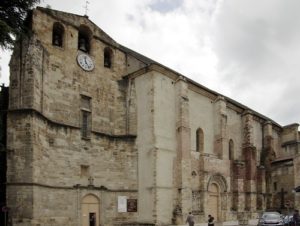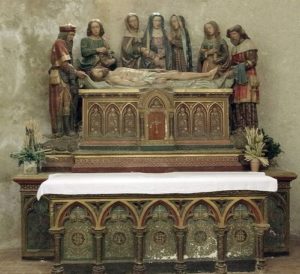Eglise St Volusien in the old town is usually locked but Sunday mass was just finishing so we were able to go in for a quick look.
The original building dates from about 800AD and was a Benedictine Abbey built to house the tomb of St Volusien, a bishop of Tours who died here in the 5thC. The church was reconstructed in 1112 by Compte de Foix, Roger II. The south entrance and the crypt date from this time. The rest of the building was ruined during the Wars of Religion and rebuilt in the 17thC.
The building is a mixture of pale stone, plaster and long narrow pink bricks. It is a big building with a massive nave and buttressed apses at the east end. The low square bell tower has bells in an open belfry on the south side with a clock beneath. The solid corner buttresses are topped with pinnacles. Along the north wall is the large pale coloured Prefecture building.
The south doorway is no longer used and is a typical rather plain Romanesque door with pillars with carved capitals supporting round arches.
Entry was through an even plainer door in the bell tower with a portico with a cross above it. This leads into a vaulted area t the back of the church with multi-angular pillars with gilded capitals. Above is the gallery with a large organ with a carved wood case with pinnacles and spires. On the south side behind a metal grille is the font. On the north wall is a war memorial.
The nave is very plain with a vaulted ceiling and large oil paintings on the walls and simple wooden pews. On the north wall is a carved dark wood pulpit with sounding board above with a sunburst on the underside and an open cupola with a globe and cross at the top.
The chancel area is on a large raised dais reached by steps. This has a modern stone table altar surrounded on three sides by choir stalls. These have carved figures on the arms and carved misericords. Steps on the north side lead down to a tiny crypt below. There is no light and it is impossible to see any detail.
Round the back of the chancel are small apses containing alters and reredos set under pointed arches. The highlight is the mise en tombeau in the central apse. The blue and gilt altar has IHS and M monograms set in arches on the base. On either side of the host box are small painted arches with a gilt floral decoration. Above this is the entombment scene with Joseph of Arimathea and Nicodemus holding the shroud with the body of Christ. Above are the weeping figures of the four Marys (Virgin Mary, Mary Magdalene, Mary Salome and Mary the wife of Cloephas) with St john Evangelist. It is a touching and very moving scene.
In another chapel, the reredos has carvings of Joseph with the young Jesus, Jesus raising Lazarus from the dead, flight into Egypt and a bishop consecrating a marriage.
Another has Mary with the Christ Child in the centre with the presentation of Jesus at the temple on one side and St Ann giving birth to the Virgin MAry on the other.
The south transept altar has a carving of the last supper on the base. The reredos has a polychrome carving of St Volusien at the top set in a carved apse. On either side of him are carvings of the instruments of the Passion. Below, to the left of the host box is a carving of the angel is appearing to Christ in the Garden of Gethsemane, on the right, Jesus is appearing to Mary Magdalene on Easter morning.
The north transept has an elaborately painted reredos with the Virgin and Christ Child in the centre. There are carvings of the annunciation, presentation at the temple and Mary weeping over the dead body of Christ.
Although only a short visit, we were pleased to have been able to get into the Church. You have about 30 minutes while the church is tidied up after the service has ended. It is worth doing.









